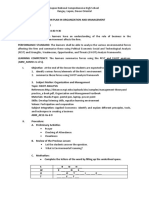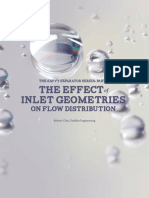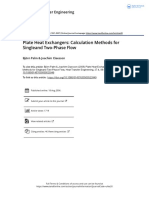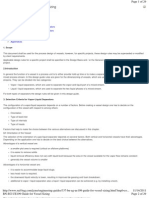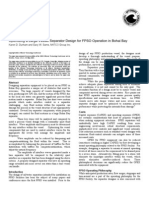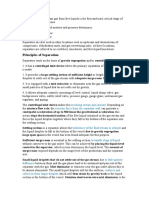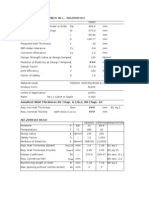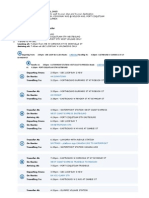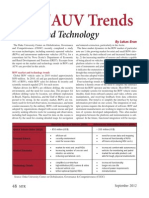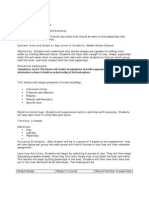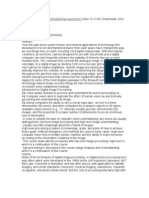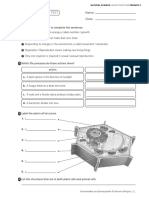Separator Design Guide
Separator Design Guide
Uploaded by
laleye_olumideCopyright:
Available Formats
Separator Design Guide
Separator Design Guide
Uploaded by
laleye_olumideOriginal Description:
Copyright
Available Formats
Share this document
Did you find this document useful?
Is this content inappropriate?
Copyright:
Available Formats
Separator Design Guide
Separator Design Guide
Uploaded by
laleye_olumideCopyright:
Available Formats
1. INTRODUCTION Separators play an important role in the chemical industry and are critical to t he success of almost all processes.
The usage of phase separators range from functions as diverse as ensuring that final product quality meets often stringen t standards to protecting downstream equipment from undesirable impurities. In the petrochemical industry the most common uses include: Separation of liquid hydrocarbon from a hydrocarbon vapour (2-phase vapour liqui d separation) Separation of a two liquids differing in their respective densities (2-phase, li quid liquid separation) Separation of a feed stream consisting of vapour, liquid hydrocarbon and water i nto 3 separate components. (3-phase separation). Some examples of separators are as follows: 2-Phase Separators Fuel gas KO drum Compressor KO drum Relief gas KO drum Crude unit desalter Amine absorber KO drum Coalescer units 3-Phase Separators Glycol Separator Hydrotreater high pressure separator Wet column reflux drum Production separator
This design guide presents the basic principles and methods involved with sizing vertical and horizontal separators for both 2-phase and 3-phase separation. It is important to note, however, that this guide does not cover the separation of solids from either liquids or vapour. Whilst theoretically, it may be important to take into consideration dynamic ope rating conditions of the separation process, such as variation in fluid properti es with time; and the transient start-up and shut-down characteristics of separa tion operation when undertaking the design, this presents a near impossible task in reality. As such, this design guide uses steady-state operation of the sepa rator as its basis. 2. DESIGN CONSIDERATIONS As is the case with the design of any vessel, the associated system properties a nd process requirements must first be defined. In the case of separator design, these may include: System Properties Flow rates of each phase to be separated. Physical properties of each phase (viscosity, density, etc.) Identification of continuous phase(s) (see following table) . System Continuous / discontinuous phase distinction Vapour Liquid The vapour is the continuous light phase, with liquid being the he avy, discontinuous phase which settles out as droplets. HC liquid Water. The HC liquid is the continuous phase, with water settli ng out as droplets Water HC liquid The water is the continuous, heavy phase, with HC liquid being the light discontinuous phase rising up through the water as droplets. Process Requirements The required throughput and composition of feed mixture to be purified will ulti mately determine the size and type of separator selected. Degree of separation required. The minimum droplet sizes required to be separat ed from each phase need to be specified. This is generally set by factors such
as purity of product required for sale or purity required to avoid upsets to dow nstream equipment / processes. For example: In HC liquid vapour separation, efficient liquid separation from vapour is neede d, particularly in situations where the vapour subsequently flows downstream to a compressor. Separators for this purpose often include mist eliminators to enh ance their separation performance. In water HC liquid separation, efficient separation of water from the HC is need ed to avoid over-loading downstream water treatment facilities. This is particu larly important if the liquid HC is then fed to a downstream distillation column . 3. HORIZONTAL VS VERTICAL SEPARATOR SELECTION Before a judgement is made regarding the type of separator most suitable for use in a specific application, there are number of factors that need to be taken in to consideration. The following sections outline the general characteristics of both horizontal and vertical separators and where they are most useful. It is i mportant to note, however, there are exceptions to these recommendations and eac h specific case should be evaluated before any decision is made. For ease of reading, when comparing the performances of vertical and horizontal separators in this section, the light phase will be referred to as vapour and the heavy phase as liquid, even in the case of liquid-liquid systems. 3.1 Theory of Horizontal Separators In terms of equivalent vapour flow areas, horizontal separators are more efficie nt than are their vertical counterparts, due largely to the fact that the liquid settles out perpendicular to the direction of vapour flow, rather than in a dir ection countering the vapour flow (as is the case with vertical separators). If the residence time of the vapour is greater than the time taken for the liqu id droplets to reach the liquid surface, then the liquid will undergo satisfacto ry disengagement from the vapour. It is this relationship which ultimately dete rmines the maximum allowable vapour velocity through the separator, as follows: Equation 3.1 Where L Vs d to follow in H Vmax = distance between feed inlet and vapour outlet. = liquid droplet settling velocity (details of calculation metho section 4) = distance between top of drum and Normal Liquid Level (NLL) = maximum allowable vapour velocity
Thus, for horizontal separators with a L/H ratio greater than 1, the maximum vel ocity can exceed the liquid settling velocity without affecting the vessels abili ty to achieve satisfactory separation. As will be shown in section 3.2, however , this is not the case with vertical separators. Horizontal separators are most efficient where large volumes of liquids are pres ent with the vapour or alternatively, when large volumes of vapour are dissolved in the liquid phase(s). They are generally used in applications such as 3-phas e separators, high-pressure vapour-liquid separators, relief KO drums and liquid -liquid separators, although there are frequent exceptions. 3.2 Theory of Vertical Separators In the case of a vertical separator, the liquid droplets settle out in a directi on opposite to the direction of vapour flow. Therefore, the liquid will not dis engage from the vapour unless the vapour velocity is lower than the liquid settl ing velocity. That is, Equation 3.2 Despite the fact that vertical separators are a less efficient alternative than
horizontal ones with an appropriate L/H ratio, they do offer some distinct advan tages which have seen them favoured for applications as fuel gas and compressor suction KO drums. Such advantages are detailed in section 3.4. 3.3 Theory of Separators Applied To V-L Systems In reality, the maximum allowable vapour velocity for liquid-vapour systems is h ighly dependent on the specific separator application and indeed is vastly diffe rent, for example, in cases where a demister pad is installed and cases where on e is not. Such flexibility is not catered for using Equations 3.1 and 3.2, wher e it is not possible to effectively take into consideration any variation in sep arator characteristics. Instead, a more appropriate equation to use for calcula ting the maximum allowable vapour velocity for vapour-liquid systems is as follo ws: Where Equation 3.3 vmax = Maximum allowable vapour velocity, m/s K = Empirical constant, m/s l = Density of liquid phase, kg/m3 v = Density of vapour phase, kg/m3
A range of values for K are available for use in the above equation, as illustra ted in the following table (Table-3.1) taken from figure 7-9 of GPSA (SI units) Volume 1, Section 7, page 7-7.
Table- 3.1 Typical K & C Factors for Sizing Woven Wire Demisters Separator Type K Factor (m/s) Horizontal 0.12 to 0.15 Vertical 0.05 to 0.11 Spherical 0.05 to 0.11 Wet Steam 0.076 270 Most vapours under vacuum Salt & Caustic Evaporators Adjustment of K & C Factor for Atmospheric 1000 kPa 2000 kPa 4000 kPa 8000 kPa 100 90 85 80 75 For glycol and amine solutions, multiply K by 0.6 to 0.8. Typical use one-half of the above K or C values for approximate sizing of vertic al separators without wire demisters. For compressors suction scrubbers and expander inlet separators multiply K by 0. 7 to 0.8. C Factor (m/hr) 420 to 540 200 to 400 220 to 400 0.061 220 0.046 160 Pressure - % of design value.
You might also like
- (Doi 10.1021/ie50289a025) M. Souders G. G. Brown - Design of Fractionating Columns I. Entrainment and Capacity PDFDocument6 pages(Doi 10.1021/ie50289a025) M. Souders G. G. Brown - Design of Fractionating Columns I. Entrainment and Capacity PDFJuan Camilo HenaoNo ratings yet
- Chapter 4 (A) General Theory & Two Phase SeparatorsDocument139 pagesChapter 4 (A) General Theory & Two Phase Separatorsdinesh_hsenid100% (3)
- Lesson Plan in SwotDocument7 pagesLesson Plan in SwotFlorentina Visto67% (3)
- Ed Lapiz ProfileDocument3 pagesEd Lapiz ProfileDioscoro MacalamNo ratings yet
- CWS 315 2I en StudentManual 4 5 Days v02Document600 pagesCWS 315 2I en StudentManual 4 5 Days v02Onurcan YahyaoğluNo ratings yet
- Rise and Shine in English SB 4Document21 pagesRise and Shine in English SB 4Lineros Rodríguez LigiaNo ratings yet
- Three Phase Separator DesignDocument5 pagesThree Phase Separator DesignAymen KhlifiNo ratings yet
- By Inge DanielsDocument3 pagesBy Inge DanielsJude Valdez ArnaizNo ratings yet
- Christopher Bruell On Aristotle's Metaphysics, Book LambdaDocument10 pagesChristopher Bruell On Aristotle's Metaphysics, Book LambdaDiegoNo ratings yet
- Separator DesignDocument8 pagesSeparator Designmohamed_sahnoun_enisNo ratings yet
- 2 3 Phase Separation SystemDocument14 pages2 3 Phase Separation SystemDodiya Nikunj100% (1)
- Open Drain Separator SizingDocument23 pagesOpen Drain Separator SizingSuchart TarasapNo ratings yet
- Input Data Operating Condition: MP Production Separator Horizontal TypeDocument6 pagesInput Data Operating Condition: MP Production Separator Horizontal Typeadi SaputraNo ratings yet
- Default Separator CalculationDocument209 pagesDefault Separator CalculationzamijakaNo ratings yet
- The Curious Behavior of Homogeneous Azeotropic Distillation-Implications For Entrainer SelectionDocument20 pagesThe Curious Behavior of Homogeneous Azeotropic Distillation-Implications For Entrainer SelectionkarimifarhadNo ratings yet
- Equilibrium Data - Water and Acetic Acid, Water and Methanol, and Water and EthanolDocument6 pagesEquilibrium Data - Water and Acetic Acid, Water and Methanol, and Water and EthanolBarbara RicciNo ratings yet
- Quantifying Oil - Water Separation Performance in Three-Phase Separators-Part 1 PDFDocument12 pagesQuantifying Oil - Water Separation Performance in Three-Phase Separators-Part 1 PDFRaghulal SethumadhavanNo ratings yet
- Oil Characterization 1Document16 pagesOil Characterization 1Muhammad Kabir MusaNo ratings yet
- 3G4 Distillation CalculationsDocument22 pages3G4 Distillation CalculationsMahmoud Nasr0% (1)
- Gas-Liquid Separators PDFDocument9 pagesGas-Liquid Separators PDFMubarik AliNo ratings yet
- Refrig JT Plant Brochures - SNC - Valerus - Recd 20170623Document4 pagesRefrig JT Plant Brochures - SNC - Valerus - Recd 20170623johnNo ratings yet
- Hydraulic Analysis Report - B1 - INT-1Document42 pagesHydraulic Analysis Report - B1 - INT-1sunnypawar1996No ratings yet
- NGL Fractionation Train Hysys Sim ReportDocument6 pagesNGL Fractionation Train Hysys Sim ReportOsas Uwoghiren100% (1)
- See Sheet API-2000: Normal Venting Liquid Movement Thermal EffectDocument33 pagesSee Sheet API-2000: Normal Venting Liquid Movement Thermal EffecthhvgNo ratings yet
- New CalculationDocument9 pagesNew CalculationDeepak Shakya100% (1)
- Separator DesignDocument4 pagesSeparator DesignTifano KhristiyantoNo ratings yet
- Inlet Geometry Flow Distribution SeparatorDocument5 pagesInlet Geometry Flow Distribution Separatorchemsac2No ratings yet
- Supervisor: Co-Supervisor: Siguird SKOGESTAD Student:: Krister FORSMAN Quang Khoa LEDocument31 pagesSupervisor: Co-Supervisor: Siguird SKOGESTAD Student:: Krister FORSMAN Quang Khoa LEShuXianNo ratings yet
- Three Phase Horizontal SeparatorDocument6 pagesThree Phase Horizontal SeparatorHani KirmaniNo ratings yet
- Coulson& Richardson - Cap.10 Gas-Liquid Separation PDFDocument6 pagesCoulson& Richardson - Cap.10 Gas-Liquid Separation PDFHoney TiwariNo ratings yet
- Dynamic SimulationDocument22 pagesDynamic SimulationUsama IqbalNo ratings yet
- Real Separator GuideDocument23 pagesReal Separator GuideMuhammad Athar100% (6)
- UNIT - SeparatorDocument39 pagesUNIT - SeparatorRakesh KumarNo ratings yet
- Vertical Separator SizingDocument3 pagesVertical Separator SizingIRVINGNo ratings yet
- Chemical & Process Technology: Simple Method For Compressor Settle Out Using HYSYSDocument3 pagesChemical & Process Technology: Simple Method For Compressor Settle Out Using HYSYSJhnteller1100% (1)
- Vertical SeparatorDocument0 pagesVertical SeparatorMohammad Nabil AbdullahNo ratings yet
- Sizing Sheet of Vertical 2-Phase Separator As Per API 12JDocument5 pagesSizing Sheet of Vertical 2-Phase Separator As Per API 12JWickyNo ratings yet
- Vacuum Distillation in Petroleum RefineryDocument3 pagesVacuum Distillation in Petroleum RefineryAdelmo FilhoNo ratings yet
- Natural Gas Dehydration-Netusil & DitlDocument20 pagesNatural Gas Dehydration-Netusil & DitlClemenNo ratings yet
- Heat-Exchanger Bypass Control: William L. LuybenDocument9 pagesHeat-Exchanger Bypass Control: William L. LuybenYu Hui100% (1)
- Plate Heat Exchangers Calculation Methods For Singleand Two Phase Flow PDFDocument12 pagesPlate Heat Exchangers Calculation Methods For Singleand Two Phase Flow PDFFrandhoni UtomoNo ratings yet
- Separator Sizing SpreadsheetDocument40 pagesSeparator Sizing SpreadsheetWalid Ben Husein100% (3)
- Dynamics Quick Guide BetaDocument15 pagesDynamics Quick Guide BetaCHANADASNo ratings yet
- Hextran Getting Started GuideDocument56 pagesHextran Getting Started GuideFelix Lara100% (1)
- Example 1: Size A 2-Phase Vertical Separator: Job SpecificationsDocument20 pagesExample 1: Size A 2-Phase Vertical Separator: Job SpecificationsLeonardo Ramirez GuzmanNo ratings yet
- SPE-173598-MS A Simplified Approach To Sizing 2 and 3 Phase Separators PDFDocument21 pagesSPE-173598-MS A Simplified Approach To Sizing 2 and 3 Phase Separators PDFRicardo VargasNo ratings yet
- Separators SizingDocument16 pagesSeparators SizingRonald GeorgeNo ratings yet
- Lower and Higher Heating Values of Gas Liquid and Solid FuelsDocument4 pagesLower and Higher Heating Values of Gas Liquid and Solid FuelsuvsarathiNo ratings yet
- Construct A Pre-Heat Train Model Workshop: ObjectiveDocument26 pagesConstruct A Pre-Heat Train Model Workshop: Objectivemiri-256No ratings yet
- Hydrotreater Revamps MUSTANG PTQDocument4 pagesHydrotreater Revamps MUSTANG PTQDavid SmithNo ratings yet
- Hysys, Absorption Column DesignDocument13 pagesHysys, Absorption Column Designrarunr1No ratings yet
- BN-EG-UE109 Guide For Vessel SizingDocument29 pagesBN-EG-UE109 Guide For Vessel SizingSachin ChavanNo ratings yet
- Optimising Safety Relief and Flare SystemsDocument8 pagesOptimising Safety Relief and Flare SystemsJoseph McMullenNo ratings yet
- T (Jam) Pws (Psig) : Chart TitleDocument15 pagesT (Jam) Pws (Psig) : Chart TitleFajar Putra NugrahaNo ratings yet
- Drizo IranDocument12 pagesDrizo IranDiego1980bNo ratings yet
- Application of Evolutionary Computational Approach in Design of Horizontal Three-Phase Gravity SeparatorsDocument8 pagesApplication of Evolutionary Computational Approach in Design of Horizontal Three-Phase Gravity Separatorsagnotts2009No ratings yet
- Optimizing A Large Vessel Separator DesignDocument9 pagesOptimizing A Large Vessel Separator DesignmctimlimNo ratings yet
- ASPEN Design of Vap-Liq Separator EdtDocument6 pagesASPEN Design of Vap-Liq Separator EdtethanNo ratings yet
- Deactivation of Heavy Oil Hydroprocessing Catalysts: Fundamentals and ModelingFrom EverandDeactivation of Heavy Oil Hydroprocessing Catalysts: Fundamentals and ModelingNo ratings yet
- Chemical Reactor Design, Optimization, and ScaleupFrom EverandChemical Reactor Design, Optimization, and ScaleupRating: 5 out of 5 stars5/5 (1)
- BN-EG-UE109 Guide For Vessel SizingDocument36 pagesBN-EG-UE109 Guide For Vessel SizingAjith KumarNo ratings yet
- Oil& Gas SeparationDocument9 pagesOil& Gas SeparationHomam MohammadNo ratings yet
- Principles of Separation: Incoming Stream Spin Around Reaction Force From The Separator WallDocument10 pagesPrinciples of Separation: Incoming Stream Spin Around Reaction Force From The Separator Wallmohamad alamehNo ratings yet
- 3.4 SeparatorDocument44 pages3.4 SeparatorzamirbabiNo ratings yet
- Chapter 4 SeparatorsDocument109 pagesChapter 4 Separatorsdinesh_hsenid100% (1)
- BN-EG-UE109 Guide For Vessel SizingDocument28 pagesBN-EG-UE109 Guide For Vessel Sizingeulalio_méndezNo ratings yet
- Position Description: (Financial, Operational, Etc)Document4 pagesPosition Description: (Financial, Operational, Etc)laleye_olumideNo ratings yet
- RFQ Cs Fiittings2Document21 pagesRFQ Cs Fiittings2laleye_olumideNo ratings yet
- AD2000 (31barg) CalculationDocument10 pagesAD2000 (31barg) CalculationMagdaline Matabang100% (1)
- Offshore & Structural Plate SizeDocument4 pagesOffshore & Structural Plate Sizelaleye_olumideNo ratings yet
- Separator Fundamentals - Process DesignDocument30 pagesSeparator Fundamentals - Process Designlaleye_olumide100% (3)
- Pressure Vessel PresentationDocument18 pagesPressure Vessel Presentationlaleye_olumide0% (1)
- Mechanical TestDocument10 pagesMechanical Testlaleye_olumideNo ratings yet
- PV Elite 2008Document3 pagesPV Elite 2008laleye_olumideNo ratings yet
- Remotely Operated Vehicles Market ReportDocument23 pagesRemotely Operated Vehicles Market Reportlaleye_olumideNo ratings yet
- ThessaloniansDocument89 pagesThessalonianslaleye_olumideNo ratings yet
- Eni in NigeriaDocument4 pagesEni in Nigerialaleye_olumideNo ratings yet
- Epf Crude Oil TreatmentDocument1 pageEpf Crude Oil Treatmentafroznishat100% (2)
- SSETP 02 00 Agenda 5th EdDocument1 pageSSETP 02 00 Agenda 5th Edlaleye_olumideNo ratings yet
- Amount/Sq Metre (Dollars) @142naira Per UsdollarDocument6 pagesAmount/Sq Metre (Dollars) @142naira Per Usdollarlaleye_olumideNo ratings yet
- Remember To Leave Enough Time To Walk To Your Stop and To Your DestinationDocument2 pagesRemember To Leave Enough Time To Walk To Your Stop and To Your Destinationlaleye_olumideNo ratings yet
- 2012-09-01 Brun ROV AUVtrends MarineTechnologyReporterDocument4 pages2012-09-01 Brun ROV AUVtrends MarineTechnologyReporterlaleye_olumideNo ratings yet
- Total Cost Total Space Cost/sq MT Annual Cost/sq MTR $/SQ MTR Rent 395,799,446.00 4,099.00 96,560.00 24,140.00 178.81 Service ChargesDocument1 pageTotal Cost Total Space Cost/sq MT Annual Cost/sq MTR $/SQ MTR Rent 395,799,446.00 4,099.00 96,560.00 24,140.00 178.81 Service Chargeslaleye_olumideNo ratings yet
- Authorization Form For ApplicationsDocument1 pageAuthorization Form For Applicationslaleye_olumideNo ratings yet
- Hydrostatic Test ProcedureDocument7 pagesHydrostatic Test Procedurelaleye_olumideNo ratings yet
- Separator Design GuideDocument36 pagesSeparator Design Guidelaleye_olumide100% (18)
- TW B2 TRAVELLING SW BW Alternative WaysDocument2 pagesTW B2 TRAVELLING SW BW Alternative WaysdavidNo ratings yet
- Test: Module 9 VocabularyDocument6 pagesTest: Module 9 VocabularyMelissaCastro070% (1)
- Dakota State University College of Education Lesson Plan FormatDocument6 pagesDakota State University College of Education Lesson Plan Formatapi-568329686No ratings yet
- Clay Boats Lesson PlanDocument2 pagesClay Boats Lesson PlancaseyfarmerNo ratings yet
- Digital Image Processing Full ReportDocument4 pagesDigital Image Processing Full ReportLovepreet VirkNo ratings yet
- 61 Spesifikasi PRIMAMED SCHWERT Dental Instrument Set For School-Kit UKGSDocument1 page61 Spesifikasi PRIMAMED SCHWERT Dental Instrument Set For School-Kit UKGSSarahNo ratings yet
- UAE Email ListDocument18 pagesUAE Email ListSneha Dalwadi40% (5)
- FM and Service DeliveryDocument3 pagesFM and Service DeliveryrenvNo ratings yet
- Synthesis: Modern ProductionDocument2 pagesSynthesis: Modern ProductionVinod NairNo ratings yet
- TS 2013 Catalog EmailDocument28 pagesTS 2013 Catalog EmailRachel GordonNo ratings yet
- Review For Final TestDocument6 pagesReview For Final TestThái Bình PhạmNo ratings yet
- Gesture Language Translator Using Raspberry PiDocument7 pagesGesture Language Translator Using Raspberry PiIJRASETPublicationsNo ratings yet
- Infiltración Grasa y Atrofia MuscularDocument11 pagesInfiltración Grasa y Atrofia MuscularJose Antonio Pareja-EstebanNo ratings yet
- 5d885b7d71cd0 Round 1 - EGuerra - D2CDocument2 pages5d885b7d71cd0 Round 1 - EGuerra - D2CMukund AgarwalNo ratings yet
- Psychology Powerpoint - Self MotivationDocument53 pagesPsychology Powerpoint - Self MotivationAlpha Beta100% (1)
- The Wavy Tunnel: Trade Management Jody SamuelsDocument40 pagesThe Wavy Tunnel: Trade Management Jody SamuelsPeter Nguyen100% (1)
- Module 1 - Answer SheetDocument5 pagesModule 1 - Answer Sheetdioco100% (1)
- Premix SRC-2: Ready Mixed Rush Coat For Fair Faced ConcreteDocument2 pagesPremix SRC-2: Ready Mixed Rush Coat For Fair Faced Concretesk mukhtarNo ratings yet
- Gifts Static Encounters ChangesDocument4 pagesGifts Static Encounters ChangesKUMP DR SITINo ratings yet
- Tamil Nadu FinTech Policy 2021 Final WebDocument36 pagesTamil Nadu FinTech Policy 2021 Final WebSabarish RockersNo ratings yet
- Unit I - IvDocument75 pagesUnit I - IvSparsh JainNo ratings yet
- FilteredspeakertoolkitDocument27 pagesFilteredspeakertoolkitapi-239074172No ratings yet
- Infiniti 2.0-Liter Vc-Turbo Engine: World First PowerDocument1 pageInfiniti 2.0-Liter Vc-Turbo Engine: World First PowerNguyen ThaiNo ratings yet
- 05.end of Unit Test U1Document2 pages05.end of Unit Test U1OCHANDO MARTINEZ MONICANo ratings yet


